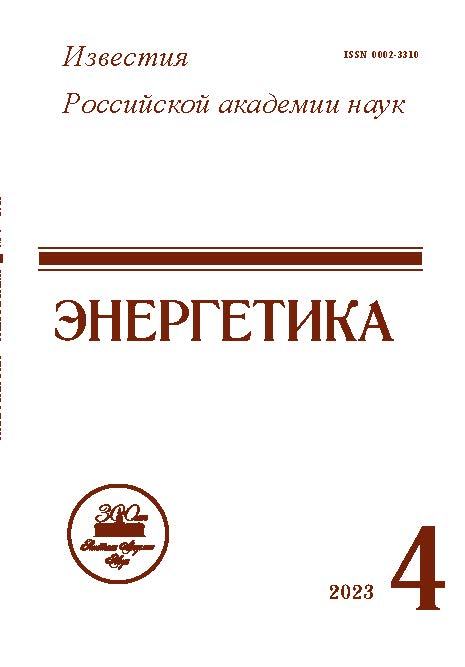Principles of Multivariate Analysis in the Reltran Program for the Problems of Estimating Public Exposure Doses during the Decommissioning of Nuclear Facilities
- Authors: Kiselev A.A.1
-
Affiliations:
- Nuclear Safety Institute, Russian Academy of Sciences
- Issue: No 4 (2023)
- Pages: 54-65
- Section: Articles
- URL: https://ruspoj.com/0002-3310/article/view/660206
- DOI: https://doi.org/10.31857/S0002331023040064
- EDN: https://elibrary.ru/YLGJVL
- ID: 660206
Cite item
Abstract
The article represents the approaches introduced in the RELTRAN code developed under the FTP NRS-2 to modeling the radiation consequences for the population caused by possible releases of radioactive substances into the atmosphere during the planned work on the decommissioning of nuclear facilities. One of the tasks of the RELTRAN code is to perform calculations of the consequences of radioactive releases for the population for the tasks of justifying radiation safety. Several modeling options are considered: calculations based on average concentrations over several years, calculations based on average concentrations over several years, considering the schedule of the decommissioning process, case-study modeling approach based on historical meteorological series analysis and case-study modeling approach based on historical meteorological series analysis, considering the schedule of the decommissioning process. It was obtained that, depending on the duration of the planned process and depending on the season, the results differ significantly, for medium-term work, their seasonality becomes an important factor, at the same time, work with conditionally constant emissions lasting more than 6 months has a negligible uncertainty associated with time start of work.
About the authors
A. A. Kiselev
Nuclear Safety Institute, Russian Academy of Sciences
Author for correspondence.
Email: aak@ibrae.ac.ru
Russia, Moscow
References
- RODOS-based Simulation of Potential Accident Scenarios for Emergency Response Management in the Vicinity of Nuclear Power Plants, 12.09.2016 [Электронный ресурс]. – URL: https://doris. bfs.de/jspui/bitstream/urn:nbn:de:0221-2016091214084/3/BfS-SCHR-60-16.pdf (дата обращения 26.09.2021).
- Rossi J., Ilvoinen M. Dose estimates at long distances from severe accidents VTT-R-00589-16 VTT, 2016. 41 p.
- Morozov V.B., Kiselev A.E., Kiselev A.A., Dolganov K.S., Tomashchik D.Yu., Krasnoperov S.N. (2020) Issues of Safety Assessment of New Russian NPP Projects in View of Current Requirements for the Probability of a Large Release, Nuclear Technology. https://doi.org/10.1080/00295450.2020.1767998
- Руководство по безопасности при использовании атомной энергии. Рекомендуемые методы расчета параметров, необходимых для разработки и установления нормативов предельно допустимых выбросов радиоактивных веществ в атмосферный воздух. РБ-106-15: утверждено приказом Федеральной службы по экологическому, технологическому и атомному надзору от 11.11.2015 № 458.
- LONG-TERM ATMOSPHERIC DISPERSION ESTIMATES FOR ROUTINE RELEASES [Электронный ресурс] – Режим доступа: https://www.nrc.gov/docs/ML0707/ML070730713. pdf – Свободный.
- Simmonds J.R., Lawson G., Mayall A. (1995). Methodology for assessing the radiological consequences of routine releases of radionuclides to the environment. European commission. European Commission, RP 72, EUR 15760 EN, Luxembourg.
- Общие положения обеспечения безопасности объектов ядерного топливного цикла (ОПБ ОЯТЦ) (НП-016-05), утверждены постановлением Федеральной службы по экологическому, технологическому и атомному надзору от 2 декабря 2005 г. № 11.
- Правила обеспечения безопасности при выводе из эксплуатации ядерных установок ядерного топливного цикла (НП-057-17), утверждены постановлением Федеральной службы по экологическому, технологическому и атомному надзору от 14 июня 2017 г. № 205.
- Бакин Р.И. и др. Концепция разработки расчетно-прогностического комплекса RELTRAN для анализа безопасности при выбросах радиоактивных веществ в атмосферу // Вопросы радиационной безопасности. 2018. № 3. С. 27–38.
- Kiselev A.A., Krasnoperov S.N., Bakin R.I., Pripachkin D.A. The concept and current status of the RELTRAN code development for safety justification of nuclear-legacy facilities and radioactive waste disposal sites for accident scenarios related to atmospheric emissions of radionuclides Proceedings of the International Conference on Radioecology and Environmental Radioactivity; Berlin (Germany); 3–8 September 2017. P. 62–63.
- Бакин Р.И., Зарянов А.В., Киселев А.А., Красноперов С.Н., Меркушов В.П., Припачкин Д.А., Шведов А.М., Шикин А.В. Расчетно-прогностический комплекс RELTRAN для анализа объектов ядерного наследия. Разработка концепции. Препринт / Ин-т проблем безопас. развития атом. энергетики РАН, № IBRAE-2017-06. М: ИБРАЭ РАН, 2017. 18 с.
- Napier B.A., Droppo Jr.J.G., Rishel J.P. 2011. Air Dispersion Modeling of Radioactive Releases During Proposed PFP Complex Demolition Activities. Report to CH2M HILL Plateau Remediation Company. PNNL-20173, Pacific Northwest Laboratory, Richland, Washington.
- Skamarock W., Klemp J., Dudhia J. et al. Description of the Advanced Research WRF Version 3. NCAR Technical Note NCAR/TN-475+STR. 2008.
- Список индексов метеорологических станций [Электронный ресурс]. URL: http://meteomaps.ru/meteostation_codes.html (дата обращения 23.11.2021)
- Моделирование распространения радионуклидов в окружающей среде. Труды ИБРАЭ РАН под редакцией чл.-корр. Л.А. Большова. Вып. 9. М.: Наука, 2008. 229 с.
- Верификация компьютерной системы “НОСТРАДАМУС” для прогнозирования радиационной обстановки на ранней стадии аварии на АЭС. Верификационный отчет. ИБРАЭ РАН, инв. № 3431. М. 2001.
- Отчет о верификации и обосновании программного средства “Программа для расчета радиационной обстановки в мезомасштабе. Версия 1.1 (РОМ)”. Инв. № 4837-Н.4х.241.9Б.17.1018-3-Р/2. М. 2017.
- Dzama D., Semenov V., Sorokovikova O. The code rom for assessment of radiation situation on a regional scale during atmosphere radioactivity releases. Fast Reactors and Related Fuel Cycles: Next Generation Nuclear Systems for Sustainable Development (FR17). Proceedings of an International Conference Held in Yekaterinburg, Russian Federation, 26–29 June 2017, Companion CD. Ссылка в веб: https://www.iaea.org/publications/13414/fast-reactors-and-related-fuel-cycles-next-generation-nuclear-systems-for-sustainable-development-fr17
- Красноперов С.Н., Припачкин Д.А., Киселев А.А., Бакин Р.И. Разработка расчетно-прогностического комплекса “RELTRAN” для обоснования безопасности объектов наследия, пунктов захоронения радиоактивных отходов” // Тезисы докладов. Международная конференция “Безопасность исследовательских ядерных установок”. АО “ГНЦ НИИАР”, Димитровград, 22–27 мая 2017 г., с. 99.
- MODIS MODERATE RESOLUTION IAGING SPECTRORADIOMETER [Электронный ресурс]. URL: https://modis.gsfc.nasa.gov/ (дата обращения 15.11.2021)
- Shuttle Radar Topography Mission Data [Электронный ресурс], Naval Academy – Режим доступа: https://www.usna.edu/Users/oceano/pguth/md_help/html/srtm.htm – свободный. Загл. с экрана. Яз. англ.
- Emery C., Tai E., Yarwood G. Final Report. Enhanced meteorological model and perfor-mance evaluation for two Texas ozone epizodes. Work Assignment No. 31984-11 TNRCC Umbrella Contract No. 582-0-31984 Prepared for The Texas Natural Resource Conservation Commission 12118 Park 35 Circle Austin, Texas 78753; ENVIRON International Corporation 101 Rowland Way, Suite 220 Novato, CA August 31, 2001. P. 153.
- Проектная документация ОВОС для общественных обсуждений | АО “СХК” (atomsib.ru)
- Методика расчета рассеяния загрязняющих веществ в атмосфере при аварийных выбросах. РД 52.18.717-2009. Обнинск, ООО “ПРИНТ-СЕРВИС”, 2009.
Supplementary files



















